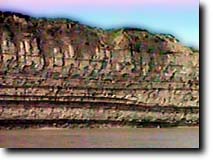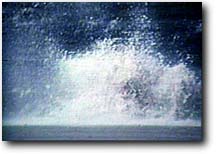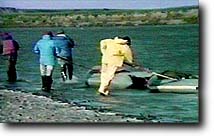
God’s perfect timing
We were hoping to make an eight mile trip today towards Ocean Point (the nearest marked map locality close to the Liscomb Bone Bed). We almost didn’t get anywhere at all. While Dan was relaxing along the river last night, he noticed a slight rise in the river. He decided to move all of our rafts, paddles, and life jackets to higher ground. This was God’s providence because the river rose one or two feet overnight and became extremely muddy. If he would not have noticed, our rafts would have been far downstream by the time we woke up the next morning. We saw God’s hand at work not only in this, but in allowing us to find the jaw bone along the river’s edge yesterday. The jaw was close enough to the river’s edge that it would have been underwater if we had floated by one day later. Thanks again Lord for your perfect timing and providential guidance.

As we traveled down the river that morning, we made excellent time. The current was moving faster because of the increased amount of water. What would God do next? How could anything surpass the events of yesterday? For the most part, the rocks along the bluff had been horizontally bedded. The rocks consisted of loosely cemented sandstones, shales, occasionally siltstones, and coal beds.
As we traveled that morning we encountered some tremendous folds and faults, highlighted by coal beds. I certainly had not expected this after all of the “boring” horizontal stratigraphy we had seen the days before. While floating along photographing folds, faults, and occasionally stopping to get a closer look at some of the rocks along the bluff, we began to hear enormous noises in the distance. Mike was the first to hear them. We wondered if someone was shooting a gun or cannon. As we rounded a large bend, to our amazement, we began to see what was happening.

Awesome geology in motion
Ahead of us, on our left was a sheer cliff, approximately 150 feet high and one half mile long. The strongest current of the river was pulling us towards the cliff, as it did most of the time. We were alarmed. In front of us we could see the cliff giving away, producing massive rock falls which were careening into the water below. This is what we had been hearing for the last half hour upstream. We began to furiously paddle, steering the boats to our right to get out of the main current on our left. Floating along the edge of this cliff would have meant certain death. The rock falls were so continuous and large we would have either been sunk by rocks falling in our boats or capsized by the waves produced from the rocks hitting the water. Finally, after twenty minutes of hard paddling, we made it to a gravel bar across the river from the falls.

Exhausted, we pulled the boats up to the beach and watched in utter astonishment from our vantage point a quarter mile away. It was like watching fireworks. You didn’t know where the next big one was going to happen. The rockfalls were continuous, one happening somewhere along the cliff at all times. Some of the boulders would plunge the full height of the cliff, landing in the water creating splashes twenty feet high or more. The falls were the result of a combination of processes and factors.
First, as we had already seen upstream the bluff was inherently unstable. Small falls and slides had already been witnessed. The rocks making up the bluff all crumble very easily.
Secondly, the strongest current of the river was at the base of the bluff, causing tremendous amounts of erosion. The river was carrying away every bit of talus building up at the cliff base. The bottom of the bluff simply could not build out. This created the sheer nature of the cliff.
Thirdly, the warm sun was melting permafrost at the top of the cliff and creating muddy waterfalls which flowed over the edge of the tundra and into the river below. I suspect this was the catalyst and lubricant which was making the falls so continuous.
This was one of the most amazing geologic spectacles I have ever seen. It was geology in motion. Watching along the half mile cliff base, no one point could be observed for more than ten seconds without at least one rock falling into the water. Watching the incredible degradation of the cliff before our eyes, we wondered how long this process could continue until the cliff disappeared.
How long has this landscape been in existence? 25 years? 100 years? Could it last 1,000 years? Could this process occur for hundreds of thousands of years? The cliff decomposing before our eyes was direct evidence for a young age of the cliff, and indirect evidence for a young age of the river, and the Earth. There is just no other reasonable way to explain why the cliff is still here and hasn’t completely eroded away.

After a nice lunch without the aid of mosquito netting, we reluctantly left our paradise, looking over our shoulders for a final glimpse of the spectacular falls. The distant booms continued for an hour as we floated away. The river began to split into many channels. We wanted to stay on the west side of the river, but the wind became stronger than the current, and we ended up in the eastern channels, much to our dismay.
No progress was made down river. Occasionally, it was faster and less tiring to get out of our boats and pull them along the beach instead of trying to paddle. Finally, we were forced to pull over and wait for the wind to die down.

On shore, the Alaskan tundra has no trees. The largest plant life here are small willow bushes, no higher than your head. They like to grow next to rivers and in low areas near a ravine or stream where they can find plenty of moisture. Mostly, the tundra is covered with grasses and a half dozen different types of wild flowers. I didn’t know their names, but we saw red, several varieties of blue, and yellow ones.
One flower I didn’t expect to see north of the Arctic Circle was the dandelion. They are not prolific, but they are here, strong and healthy. I was disappointed to find somebody’s trash in this little clearing amongst the willows. There were several tin cans (one was Spam), beer cans and other bits of waste left behind. This wasn’t the only time I came across trash. I was angry that someone would spoil the pristine Alaskan tundra like this.

Soon the wind died down and our two hour siesta was over. Paddling for a long time, and still fighting the breeze, we passed through the main channel and made it into one of the western channels. We still weren’t quite sure where we were on the map. Apparently the channels in this part of the river change so much that it is difficult to keep the maps updated. Our G.P.S. helped, but the coordinates it gave us didn’t quite match with the map (it doesn’t always give an accurate reading).
Very tired, and yet still wanting to make more progress towards Ocean Point, we stopped and had dinner about 7:30 on a sand bar. We ate quickly and began to talk about trying to make it to the bone beds that evening. However, the Lord had other plans.



